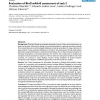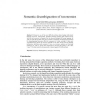53 search results - page 5 / 11 » Automatically annotating textual resources with human intent... |
SAC
2005
ACM
14 years 1 months ago
2005
ACM
A great jump towards the advent of the Semantic Web will take place when a critical mass of web resources is available for use in a semantic way. This goal can be reached by the c...
BMCBI
2005
13 years 7 months ago
2005
Background: Molecular Biology accumulated substantial amounts of data concerning functions of genes and proteins. Information relating to functional descriptions is generally extr...
CCIA
2007
Springer
14 years 1 months ago
2007
Springer
Polysemy is one of the most difficult problems when dealing with natural language resources. Consequently, automated ontology learning from textual sources (such as web resources) ...
ECIS
2000
13 years 9 months ago
2000
This paper presents a concept for the integration of quantitative and qualitative information sources with their accompanying management support functionalities from navigation and...
ESWS
2006
Springer
13 years 11 months ago
2006
Springer
Both the multilingual aspects which characterize the (Semantic) Web and the demand for more easy-to-share forms of knowledge representation, being equally accessible by humans and ...


